Por: Lando T. Nishida
8183 visualizações
Tempo leitura: 9 min
The period or "lead time" from the product conception to launch in the market is one of the most important factors to ensure the competitiveness of a company and expand the possibilities of market expansion. You can set whether the company will be the pioneer or a fast follower in certain segments or niches.
The concept of standardization is used in manufacturing to maintain stability in the processes, ensuring that activities are always performed in a certain sequence and similarly in a given time interval with the lowest level of waste, achieving high quality and high productivity. It is the basis to make future improvements, eliminating more waste and further shortening the lead time.
The implementation of standardization in product development also provides a significant reduction in "lead time" as it prevents the occurrence of waste as waiting periods, searches and corrections to the information that cause rework, both in the project area as posteriorly in manufacturing.
In this article a method is presented to perform the "kaizen" in product development, in particular to reduce the "lead time" by using the concept of standardization.
1. Identifying the products with the largest "lead times"
First, we must identify which product has the largest "lead time" for development and later analyze how to reduce it. We will use "lead times" for the same category or nature of development, for example, small, medium or complete product modification. We can identify the types of products and their respective "lead times" of development when we can possibly have a chart similar to the on below:
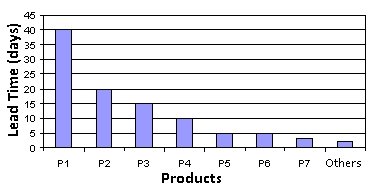
Graph 1 - "Lead Time" by product
We may note that the product P1 has the largest lead time of project. Generally those are more complex products, having many sub-components. The definition of the product with the largest lead time can help prioritize improvement efforts. Other economic-financial and strategic factors may also be important in defining the product to be focused, but the existence of high lead time tends to mean relevance and high cost.
2. Identifying the activities involved
After the product is identified (or product family), we should * identify the steps or processes through which the product passes. In a macro way, we can cite the example below, just listing the activities and their respective "lead times", as shown in Table 1.
| Activities | LT (days) |
1 | Meet the client | 1 |
2 | Approve specifications | 2 |
3 | Create basic project | 5 |
4 | Generate drawings for approval | 8 |
5 | Inspect drawings | 1 |
6 | Correct drawings | 1 |
7 | Approve drawings in the basic project | 1 |
8 | Generate detailed drawings | 15 |
9 | Inspect drawings | 1 |
10 | Approval of final drawings | 1 |
| TOTAL: | 40 |
Table 1 - Activities for Product 1
| 3. Analyzing the activities of larger "lead time" |
| About the macro processes and their "lead times" in descending order, we observed that step 8 (Generate detailed drawings) and 4 (Generate drawings for approval) represent almost 60% of the total "lead time". If we analyze in more detail the activities to generate drawings, we note that the amount of reused designs, ie, making use of files from previous projects and those made completely from scratch, is much smaller. We may ask why need to generate so many new designs or why is the reuse of projects low and would it not be possible to reduce this work that takes time and resources without harming the quality of development. Almost always we come to the conclusion that the lack of standardization in certain technical specifications take the designers to make a new drawing for every new product. | 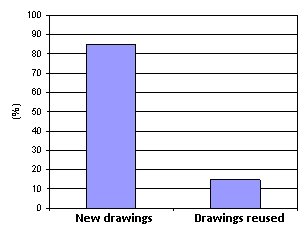
Graph 2 - News Draws x reused draws |
4. Plan for standardization
Thus it, is necessary to make an effort to increase standardization in order to increase the rate of reuse and thus, reduce the total "lead time". For this, it is important to get support from more experienced designers to conduct a plan to standardize the technical specifications, eg, size of quotas, tolerances and define which items will be standardized. Figure 1 represents a model piece with its dimensions A, B, C, D, E, F and G. We intend to create quota tables with standard dimensions (Table 2) for the various possible components, based on studies using tools like diagrams of relationships between these dimensions (Figure 3).
| 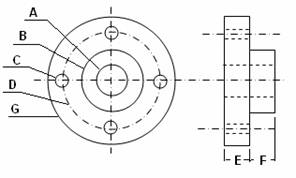
Figure 1 - Model piece | 
Table 2 - Table of standard dimensions |
With this, you can generate a database of CAD models with standard dimensions. Figure 2 shows the standard CAD drawings available, without the need to redesign them. The goal is not to draw the component for every new product, but copy and paste these standards models, thus reducing the lead time in implementing new drawings. The more patterns we have, the less time we will take to generate designs for approval or implementation of detailed drawings. It will also assist in the manufacturing stage including in the setup of machines, because it reduces the time for unnecessary adjustments for each new product. In the case of chemical or food industries among others that do not use detailed drawings in the making of products, cannot fit the standardization of measures, but standardize specifications and technical information on formulations, packaging and others.
| 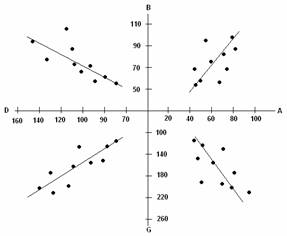
Graph 3 - Diagram of relationships between dimensions | 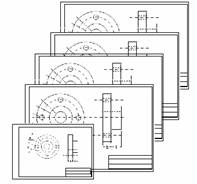
Figure 2 - Models patterns in CAD |
5. Other types of standardizations
The reason for the occurrence of long "lead times" is the existence of waste in the activities of the development process. One of the most common waste is the time spent searching for information, especially technical specifications missing, sent by the Sales department after negotiating with the customer. Many reworks happen when designers continue the project development with specifications assumed due to the lack of them. Another frequent waste is rework generated when the drawings come to production with specifications that are not compatible for manufacturing. This happens due to the acceptance of sales orders with personalized customer without consulting the department of development and manufacturing. To eliminate these reworks, we need to improve or create forms of requisition of orders, standardizing some fields. Prepare a manual for the sales staff with products specifications already pre-established with standardizations incorporated. Conduct trainings and meetings between the development team and sales staff for explanation of these standardizations. Many people may argue that rework or changes in specifications during the project are activities that add value because the effort is made, in many cases, to improve the performance of the final product. However, these actions cause different types of waste both for the company and for their suppliers. For example:
1. Materials that are no longer used;
2. Components that become obsolete;
3. Replacement of tools to support new product specifications;
4. Waiting for emissions of new orders of items;
5. Waiting for new deliveries;
6. Reassemble of the new product or component;
7. Reinspections;
6. Measuring and monitoring the "lead time"
We could only improve something if we can measure it. One of the important indicators to be measured is the monitoring of deadlines given by the relation:
Future lead time for the project
Current lead time for the project
At the factory, an entire line of production may need to stop for a single missing drawing. If this value is equal to "1", the project is on schedule. Less than "1" value, means the project is behind schedule and greater than "1", means ahead of schedule.
7. Conclusion
The standardization of component specifications in the development process is one of the most important for the reduction of the "lead time" items. Serves to eliminate noise and waste generated during the product development. The steps in this article may be useful to notice and expose waste, attack the root cause causing benefits from the process of product development by reducing the lead time of development, and consequently the total costs. These practices may be considered as a basic step for many companies, similar to the basic stability (5S, improving the availability of machines, etc.) that are required at the beginning of a lean transformation in manufacturing.
In a broader approach, we could consider the use of value stream mapping in the processes of product development, elements of lean development system, such as a set-based concurrent engineering, leadership of system designers with an entrepreneurial spirit, decentralized planning with cadence and pulled flow, frequent interactions between teams of specialists responsible where the focus is to create a stream of lucrative value and reusable knowledge that meets the needs of customers.
Bibliography
* more information about how create a Value Stream Map to product development see Liker, J. K. e Morgan, J. M. The Toyota Product Development System: Integrating People, Process And Technology, Productivity Press, 2006. - Kennedy, M. N. Product Development for the Lean Enterprise, Oaklea Press, 2003. - Marchwinksy, C e Shook, J (cords). Léxico Lean. Lean Institute Brasil, 2003. - Sekine, K., Arai, K. Design Team Revolution, Productivity Press, 1994. - Ward, A. C. The Lean Development Skill Book. Ward Syntesis, 2002.
Portuguese source: Lean Institute Brasil
In your opinion: What forms of standardization can be used in IT?
Data da publicação:
04/24/2007
-
 Lando T. Nishida
Lando T. Nishida

 Lean Institute Brasil
Mechanical Engineer at Polytechnic School of USP. Founding Partner at Lean Academy Portugal. Project Manager at Lean Institute Brasil.
As Senior Advisor at Institut Lean France, he led Lean implementation projects in several companies in Europe and Asia.
Lean Institute Brasil
Mechanical Engineer at Polytechnic School of USP. Founding Partner at Lean Academy Portugal. Project Manager at Lean Institute Brasil.
As Senior Advisor at Institut Lean France, he led Lean implementation projects in several companies in Europe and Asia.